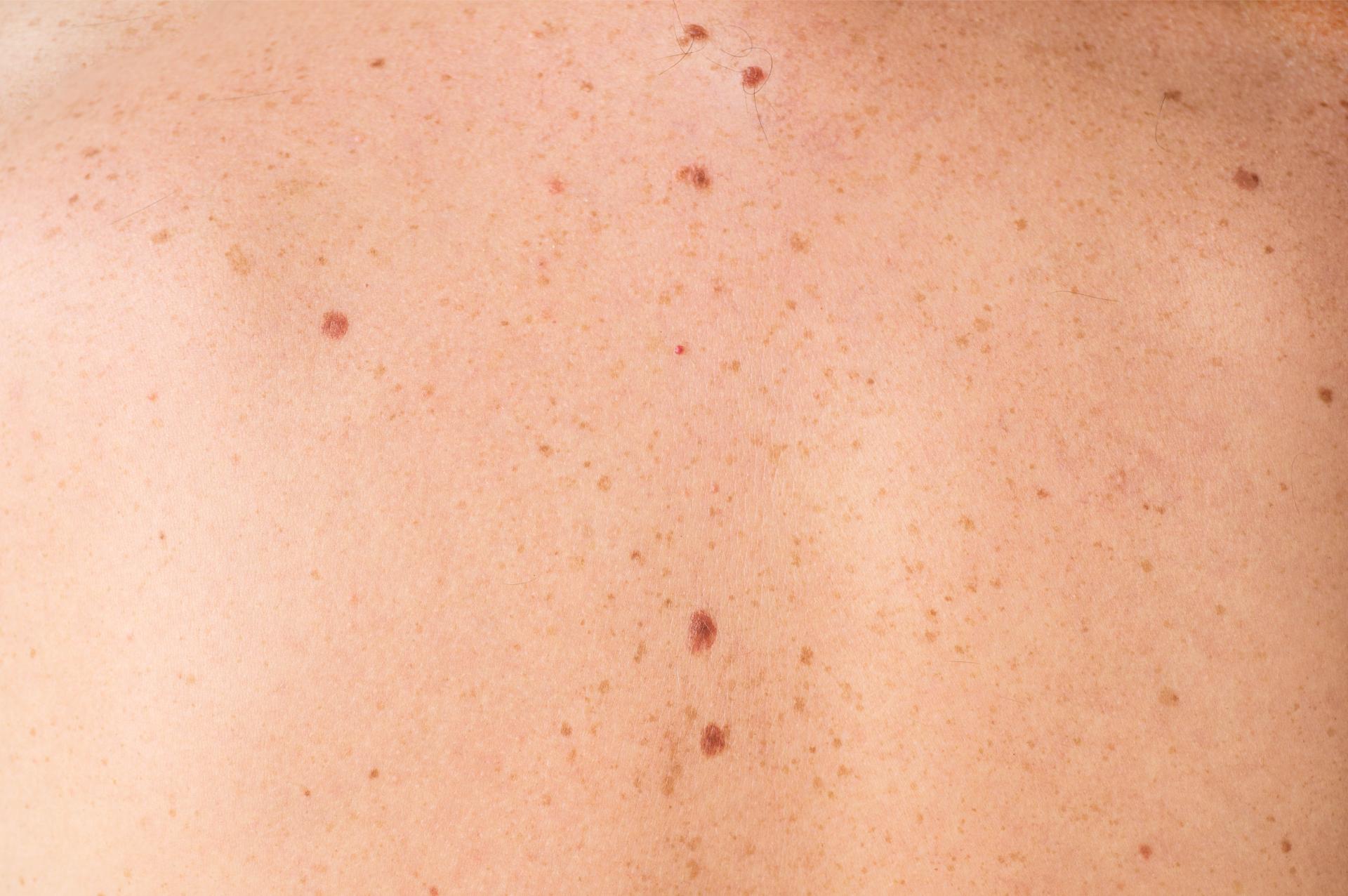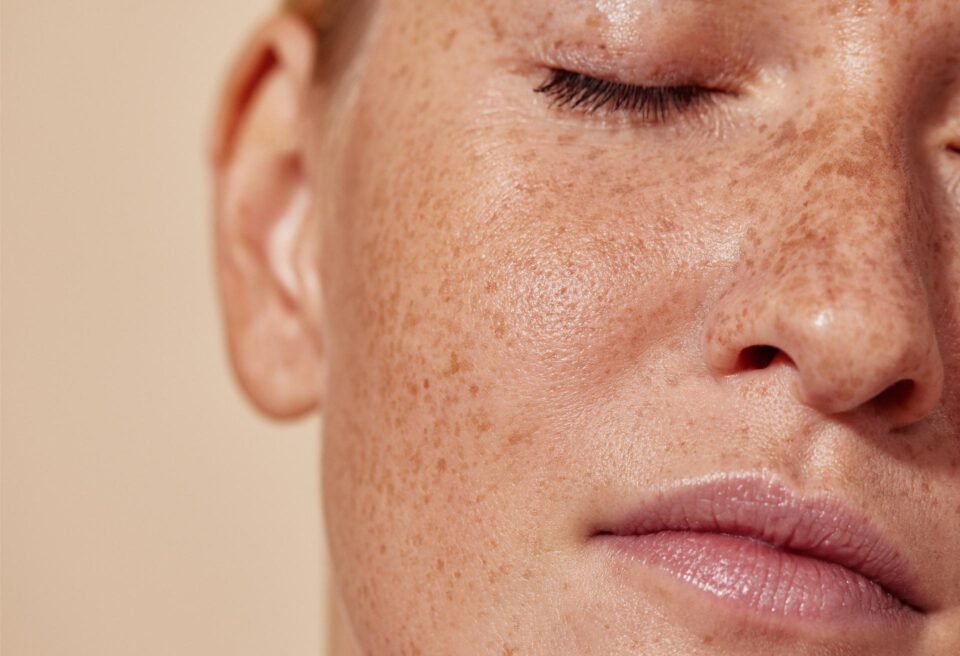Pigmentation types
Understanding pigmentation types saves time and prevents setbacks. Here is a quick guide to the main patterns we see in Queensland. Use it to match what you see in the mirror and to prepare for your consultation.
Melasma
Melasma shows as flat, irregular brown patches on the cheeks, forehead, nose and upper lip. It often darkens in summer and lightens in winter. Heat, visible light and hormones drive it. Pregnancy, some medicines and family history can play a role. Melasma can sit in surface and deeper layers of skin, which is why it needs a careful plan.
If you think your patches change with seasons or heat, we can confirm the pattern, set a baseline with photos, and map a routine that fits your day. You will know what to do morning and night, how to protect your skin outside, and what to avoid when flare risk is high.
Sunspots
Sunspots, also called solar lentigines, are discrete brown marks from cumulative UV exposure. They sit in the top layers of skin and are common in Queensland. You will see them on the face, shoulders, chest and hands. They do not fade with the seasons like melasma and often respond well to targeted care.
If you have scattered spots that do not shift much through the year, we can focus on spot specific options and a simple maintenance plan. You will learn how to prevent new spots and keep results steady.
Freckles
Freckles are small, multiple spots that darken with sun and fade with lower UV. They are usually harmless. Many people have both freckles and sunspots.
If freckles bother you in photos or in bright light, we can discuss gentle ways to soften contrast while keeping a natural look. You choose how noticeable you want the change to be.
How to tell Pigmentation Types apart

Melasma and sunspots can look similar at first glance. A short skin exam and a light based check help us separate them. Getting the type right saves you time and money.
- Response: Melasma needs strict trigger control and patient, staged care. Sunspots often respond faster to targeted in clinic options.
- Edges: Melasma has soft, map like borders. Sunspots have clearer edges.
- Pattern: Melasma appears in patches. Sunspots are individual spots.
- Season: Melasma darkens with heat and light. Sunspots stay steadier year round.
- Triggers: Melasma responds to heat, visible light and hormones. Sunspots relate to lifetime UV.
Why climate matters
Queensland has high UV for most of the year. Outdoor sport, beach time and driving add exposure. Heat can flare melasma even when you wear sunscreen. Shade, hats and cooling matter as much as SPF. Your plan should match school runs, shift work, or weekend surf, so you can stick with it.
We will tailor advice to your routine. If you work outdoors, we will prioritise shade tools, reapplication times, and clothing choices. If you work indoors, we will cover window exposure, commuting, and lunch breaks in the sun.
At-home steps that make a difference
Small daily actions add up. The goal is steady protection, low irritation, and habits you can keep up.
- Use SPF 50+ broad-spectrum every morning. Apply two finger lengths to the face and neck. Reapply every two hours if outdoors.
- Add a tinted sunscreen if you have melasma. Iron oxides help block visible light.
- Wear a wide-brimmed hat and sunglasses. Pick UPF-rated clothing for long days outside.
- Keep skin cool. Seek shade, carry a spray mist or cold pack, and avoid peak heat when you can.
- Build a simple routine. Gentle cleanser, hydrating serum, pigment-safe active, SPF in the morning. Use gentle cleanser, repair serum, and moisturiser at night.
- Avoid picking spots. Picking can cause post-inflammatory hyperpigmentation.
We will show you how to layer products, when to pause actives, and how to spot early signs of irritation. Clear steps reduce guesswork and help you stay consistent.
When to treat pigmentation in a clinic
Book a consultation if pigmentation is spreading, if home care stalls, or if you want faster gains. You will get a diagnosis, a plan and a timeline. Photos help track progress. Expect staged care, not a one-visit fix. This approach fits around work, school, and travel, so you do not lose time or momentum.
During your visit we will set realistic checkpoints. You will know what to expect after two weeks, after one month, and after a full course. You will also know how to maintain results between visits.
In clinic options we may recommend
We only recommend options after a proper assessment. Your plan will match your skin, your lifestyle and your budget. You will understand why each step is chosen and what benefit to expect.
- Medical grade peels. Useful for sunspots and uneven tone. Many plans run for 3 to 6 sessions.
- Skin needling or RF microneedling. Helps texture and some post-acne marks. We avoid energy devices for active melasma.
- Healite for recovery support. A series can calm skin and improve comfort.
We will guide prep, aftercare, and spacing between visits. You will leave with written steps to avoid any confusion at home.
What to expect over time from clinic treatments
Results depend on the type of pigment and your routine. We will measure progress with photos and honest check-ins.
- Sunspots: Many people see visible change within weeks after a targeted plan. Ongoing maintenance helps prevent new spots.
- Melasma: Expect slower gains. Strict sun, heat and light control is the base. In clinic steps are gentle and gradual. We focus on stability first.
You will have a clear maintenance plan at the end of treatment. This may include seasonal tweaks, simple product swaps, and review times.
Common myths about skin pigmentation
It is easy to get mixed messages online. Here are facts that help you make a well-informed choice.
- Sunscreen alone fixes melasma. Sunscreen helps, but heat and visible light still matter.
- Only summer causes pigment. Winter UV in Queensland can still be high.
- Stronger is better. Aggressive treatment can actually worsen melasma.
We will explain what applies to you, and what to ignore. This saves you trial and error.
Pregnancy and melasma
Melasma can start or worsen in pregnancy. Focus on sun safety, shade and gentle skincare. Delay energy treatments. Book a review after breastfeeding if needed. We can support you with product choices that fit pregnancy and with simple cooling steps for hot days.
If pigment remains after pregnancy, we will reassess and set a staged plan. You choose the pace that suits childcare and work.
Safety notes
Good results come from smart pacing and low irritation. Tell us about your skin history, allergies and medicines so we can adjust.
- Patch test sensitive skin.
- Space active products to avoid irritation.
- Disclose all medicines and health changes in your consultation.
Your skin care plan, made simple.
You want clear steps and steady gains. We will confirm your pigment type, set a routine you can follow, and schedule treatment at the right times of year. You will leave with written guidance, product tips, and the next review date so you know exactly what comes next.
We stay realistic about timelines and cost. You will know what each visit aims to achieve, how to care for your skin between sessions, and how to keep results stable through Queensland’s summer heat. When questions come up, you can reach out for advice between appointments.
